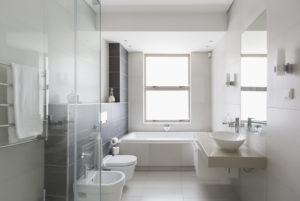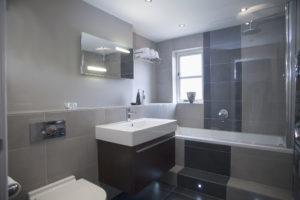
Modern bathrooms
Elegance is the name of the game with modern bathrooms. To keep up with the demands of the public, the plumbing codes and standards have changed regarding modern bathrooms. Some changes are for the good; others, well, we will have to see.
 The obsolete overflow
The obsolete overflow
One of the first major changes you should be aware of is to elegant bathtubs and whirlpool tubs. Some of the newer his-and-her bathtubs can hold up to 300 gallons of water, while others, a mere 80 gallons. When you fill a bathtub this large, the tub filler has to be flowing at a high flow rate. This requires either a 3/4- or 1-inch water line to fill the tub. Some modern tub fillers will flow 12 to 15 gpm, or higher.
Now that you have that picture, imagine a 1 1/2 inch overflow for this large tub. At that high of a fill rate, a 1 1/2 inch overflow becomes useless. I timed my own new whirlpool tub to see how long it takes to overflow the tub with the 1 1/2 inch overflow installed. It was about 90 seconds. Thus, the overflow will not serve the purpose for which it was intended, preventing an unattended bathtub from overflowing.
This is recognized by the plumbing industry, so the standards regulating bathtubs changed. An overflow is no longer mandated for a bathtub. It is an optional item that the manufacturer can choose to provide. You will find that many of the larger bathtubs and whirlpool tubs no longer have overflows.
The plumbing codes have caught up to this requirement by no longer mandating an overflow. If your jurisdiction has adopted an older version of the plumbing code, you may want to let them know of this major change.
Thresholds and accessibility
Another change, based on demand by the public, is the removal of the threshold for a walk-in shower. This may sound pretty good until you realize that the drain must be a minimum of 2 inches below the entry to the shower. Using the normal 1/4 inch per foot slope of a shower floor results in a very large shower. The distance from the entry to the drain would have to be 8 feet. The pitch of the shower floor could also be increased to reduce the size of the shower.
Once you remove the shower threshold, the entire room is often classified as a wet area. While that doesn’t impact the plumbing too much, it will impact the electrical installation. The wet room requirement is very code dependent. Not all plumbing codes will classify the room as a wet room.
On the questionable side of the changes to bathroom requirements are changes that have occurred to the Building Code. You may be asking, “Why is the Building Code regulating my plumbing?”
The Building Code regulates accessibility requirements. We often refer to that as the handicapped plumbing requirements. Every plumbing contractor is used to handicapped plumbing requirements in commercial buildings. You may also be familiar with providing a handicapped dwelling unit in larger multi-family apartments or condominiums.
The fully accessible, or handicapped, dwelling units are classified as Type A units under the accessibility requirements. The other classification is a Type B unit. Type B dwelling units must be readily able to convert to a Type A unit without major costs. To help understand what a major cost is, ICC A117.1 specifies all of the requirements for plumbing fixtures in Type B units. ICC A117.1 is the accessibility standard referenced by the Building Code.
The International Building Code requires all dwelling units, other than Type A units, to be Type B units when there are four or more dwelling units in a building. That includes virtually every multi-family dwelling. There are some exceptions but, for the most part, start thinking Type B units.
At least one bathroom in a dwelling unit must provide adequate space for turning in a wheelchair. Each fixture must be spaced similarly to handicapped fixtures.
That means that a water closet must be spaced between 16 to 18 inches from the sidewall. You cannot reduce the distance to 15 inches, as allowed in the plumbing code. You cannot increase it beyond 18 inches.
Behind the wall surrounding a water closet, there must be backing material installed that will allow grab bars to be mounted on the wall. The backing material also applies to a bathtub or shower, depending on the fixture that will serve as an accessible bathing fixture.
If a shower is installed as the fixture to convert to an accessible bathing fixture, the minimum size must be 36 inches by 36 inches. There must be clear space in front of the shower to allow an individual to transfer from a wheelchair onto a shower seat. It is easier to classify a bathtub as the accessible bathing fixture since you normally will only require backing for the grab bars.
Lavatories in a Type B unit can get tricky. Normally a lavatory is installed on, or as a part of, a vanity. Long gone are the stand alone lavatories. Today’s vanities can be rather fancy.
When using an accessible lavatory, there must be knee and toe clearance to allow access to the fixture. That means that the front of the vanity cannot be present to block the access. Basically, there is an opening in front of the fixture that allows a person in a wheelchair to gain access to the lavatory.
The standard requires the front panel of the vanity to be removable without disturbing the plumbing. While the installation of a vanity is not the responsibility of the plumbing contractor, it is regulated in the plumbing section. That means that the plumbing contractor will be notified of a violation if the building contractor installs the wrong vanity. You need to make sure the building contractor selects an acceptable vanity that has a removable front panel. The same is true for a kitchen sink.
While the Type B unit requirements may seem onerous, remember that it will help a person that is or becomes confined to a wheelchair. Also keep in mind that the accessibility requirements only apply to one bathroom in the dwelling unit. Many times, there are three or four bathrooms in a single dwelling unit.
If you do not have a copy of ICC A117.1, you may want to purchase one. In addition to the dwelling unit requirements, this standard also contains all of the plumbing requirements for accessible fixtures in commercial buildings. This standard is as important as the plumbing code when it comes to knowing the requirements for accessible (handicapped) plumbing fixtures.






